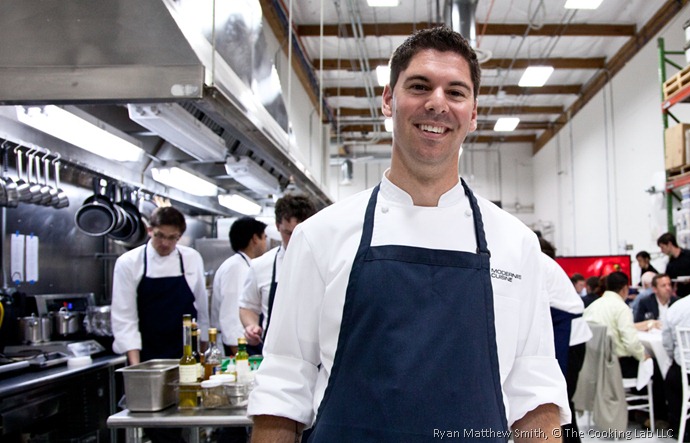
My feet hurt, my back is a mess, I’ve got blisters from endless brunoising, and my fingertips are still burning from the liquid nitrogen. It was the best week ever!
Last week, I spent four days working as a stage (pronounced stahzje, definition: cooking intern) at the Modernist Cuisine kitchen lab in Bellevue. It was an amazing experience that deepened my respect for the talent and dedication of everyone involved with the book and its promotion.
Dinner was scheduled for Thursday night and prep began on Monday morning. There were 15 guests and 30 courses. Each course was broken down into multiple components which were listed on the kitchen’s whiteboard each morning. I didn’t keep an exact count, but I estimate the number of component dishes to be somewhere around 200. There were six full-time chefs: Maxime Bilet, Johnny Zhu, Grant Crilly, Sam Fahey-Burke, Anjana Shanker, and Aaron (who transitioned from 4th week stage to full-time employee during my stint). Maxime Bilet was in and out of the lab Monday through Wednesday, wrangling suppliers and keeping a pulse on progress, but present in full-force on Thursday to lead the execution of the dinner service. Depending on the day, there were up to three stages (myself included), and of course, the hardest working guy in the kitchen, Tyson, who washed dishes non-stop.
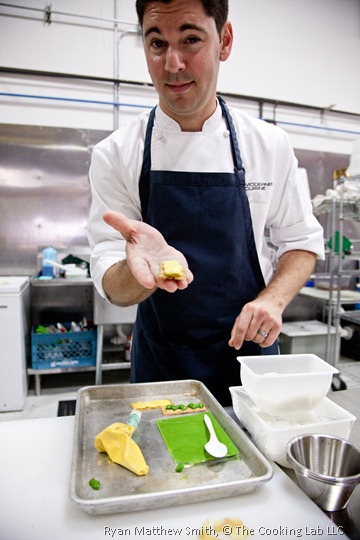 So, with that many hands on deck, how much could we possibly need to prep four days in advance? A lot, it turned out. My first order of business was to unbag, thaw, drain and juice 60 lbs. of frozen corn. This corn would ultimately become corn butter, which was served with the second course, alongside pea butter with thinly-sliced rectangles of toast. In case you’re having trouble visualizing what 60 lbs. of corn actually looks like, it’s approximately a home-sized freezer packed full. And how much butter does that yield? About 120 grams – not quite 1 cup. It’s roughly equivalent in scale to harvesting saffron, except it requires a massive centrifuge instead of dozens of Italian field laborers. It took me over three hours to juice all that corn, then divide the juice precisely into 400g bottles for the ‘fuge. Then, in batches of 6, the corn juice spun at 10,000 RPMs for an hour. The result was a product very similar to the corn butter I made at home, but with an even greater separation between the liquid and solid layers. I gently scraped the layer of corn butter out of each bottle, then, like almost every other food in the kitchen, I sealed it in a vacuum bag.
So, with that many hands on deck, how much could we possibly need to prep four days in advance? A lot, it turned out. My first order of business was to unbag, thaw, drain and juice 60 lbs. of frozen corn. This corn would ultimately become corn butter, which was served with the second course, alongside pea butter with thinly-sliced rectangles of toast. In case you’re having trouble visualizing what 60 lbs. of corn actually looks like, it’s approximately a home-sized freezer packed full. And how much butter does that yield? About 120 grams – not quite 1 cup. It’s roughly equivalent in scale to harvesting saffron, except it requires a massive centrifuge instead of dozens of Italian field laborers. It took me over three hours to juice all that corn, then divide the juice precisely into 400g bottles for the ‘fuge. Then, in batches of 6, the corn juice spun at 10,000 RPMs for an hour. The result was a product very similar to the corn butter I made at home, but with an even greater separation between the liquid and solid layers. I gently scraped the layer of corn butter out of each bottle, then, like almost every other food in the kitchen, I sealed it in a vacuum bag.
Next, I worked on my first brunoise. If you aren’t familiar with the term, “brunoise” means little, tiny cubes. The size of the cubes ranges from 1-3mm (depending on who you ask), and they are generally made by julienning foods with a mandoline, then cutting the food into strips, turning the strips 90 degrees and cutting them into cubes. It sounds pretty easy, and conceptually, it is. But in practice, this turned out to be my nemesis. Because the cubes are so small, a difference in size of .5mm can equate to 25-50%, and it’s that discrepancy is noticeable to the eye… especially eye of a chef.
My first brunoise assignment was a white onion. I’ve cut onions [at home] for years, and I’ve cut them with roughly the same technique that Sam showed me: cut off the top, split the onion in half, make a few slices with your knife parallel to the cutting board, make some more slices with your knife parallel to the onion root, then cut across the onion to produce little chunks. The difference was, I had always cut an onion for the sole purpose of turning it into small pieces. I had never before cut an onion “for service”. This turned out to be an important distinction. Foods cut for service had to be perfect… like, take-out-your-caliper-perfect. “Easy enough,” I thought. My plan was to take a little extra time and care with my knifework and, presto, perfect little cubes. Wrong! No matter how slowly I went, that asshole of an onion would invariably shatter into little round shards, extruded rhombuses, and other quadrilaterals devoid of right angles. As the week progressed, I found the same to be especially true of shallots, and to an extent, every other food that I tried laboriously to cube: candied orange peel, cucumber flesh, maitake mushrooms, and likely several other ingredients that I’ve subconsciously repressed.
At some point, each chef assigned me something to brunoise, and invariably each of them instructed me, “Take your time, do it right.” I thought this was awesome. I hadn’t previously spent much time in a working kitchen, so my expectations were largely based on clips I’d seen of reality TV chefs flipping over pans and screaming at people (often in English accents). None of this was anywhere to be found in the Modernist Cuisine kitchen. Even when timing was tight and the pressure was on, nobody lost their cool and not once was I ever made to feel incapable because of my inexperience. That’s not to say that they relaxed their standards one iota for their stages – “Those cubes are getting a little big, Scott,” was all the instruction I needed to know that I should discard my pile and start again. If a chef noticed that I was struggling with a task or a technique, he or she would stop me, help me with instructions, tips or tricks, then set me back on course. It was an amazingly supportive environment… in spite of all those little fucking cubes.
By the end of the first day, I was exhausted and I felt like I had gone barefoot ice skating on a hot lake of Microplanes. I had bought brand new non-slip work shoes for the internship and, although I had the foresight to equip them with Dr. Scholes, I was not prepared for the impact of a full day on my feet. It doesn’t happen often in the software world. When I got home, slipped off my shoes, and sank into bed, the relief was so orgasmic that it put me to sleep. 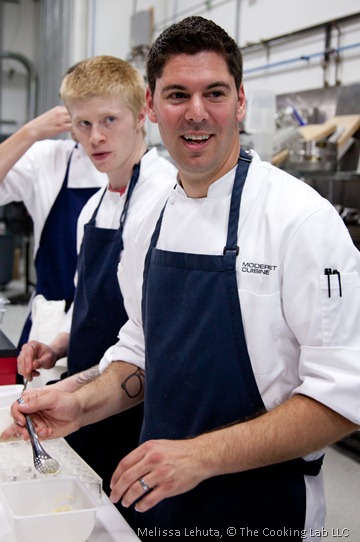
I arrived bright and early on day two and got straight to work. It’s amazing how much confidence you can build in a single day of experience: I knew my way around, I had learned most of the protocols and I had compiled a list of each chef’s known peccadillos (ex. Sam likes the saucepans hung small-to-large from right to left; Max hates it when grocery packaging touches a cutting board; Grant prefers wood boards over plastic). I marched into the kitchen confidently, grabbed an apron and a stack of towels and got straight to work. Yesterday’s whiteboard full of components had been replaced by an entirely new list, just as long.
I started on the Gazpacho, prepared in the least traditional fashion I’ve seen. This soup was made primarily from plums and pluots (a hybrid between a plum and an apricot). The sliced fruit had been marinating with other components in a vacuum bag overnight. My job was to blend it in the VitaPrep, then pass it through a tamis, discarding the thick pulp. Even though the blender did a great job pureeing the soup, the mesh of the tamis was so fine that it took me hours to scrape the soup through. The liquid that it rendered was bright orange, less viscous than water, and intensely fruit-flavored. Once I had pressed through all the liquid I could, it went straight into a vacuum bag and into the chamber sealer.
I’m told that all stages make the same mistake the first time they try to vacuum seal liquids. Some (not all) liquids start to boil and foam as the pressure in the chamber drops. As this boiling becomes more intense, it’s not uncommon for the liquid to erupt out of the unsealed bag and make a mess of the vacuum chamber. Grant was kind enough to show me a workaround: if you set the liquid in a regular upright container and pull a vacuum without trying to seal it first, you can boil off most of the dissolved gasses. Then, when you go to vacuum seal the bag, you can avoid the unpleasant flood of liquid past the sealing bar. This trick was instrumental to my success vacuum packing – only once did I make a mess of the sealer and that was from learning a different lesson: spot prawn shells are sharp as shit and will poke through a vacuum bag (or five).
Anyhow, days two and three continued at this pace. We worked from 9 until 5:30 or 6:30, busily knocking out components, vacuum sealing them, and arranging them in the quickly-diminishing refrigerator space. Some items, such as cryoshattered berries and a vacuum-set green apple foam, went straight into the deep freezer at -60C. Other items went into one of many sous vide baths humming along throughout the kitchen, and yet other components, such as the house-made cocoa pasta, were left out to dry on sheet pans.
When day four arrived, I knew it would be crunch time. We were on a great pace for delivering dinner that evening, but there were some components that we couldn’t prep until the day-of, and the tingle of anxiety in the air indicated that it would be a long, busy day. We started work at 7AM that morning. The mixing bowls and cutting boards that normally lived underneath the center prep table were swapped out for sparkling, clean dishware. Any unnecessary equipment was stashed in towering storage shelves to clear floor space for the two round tables and chairs that would seat 15 lucky guests. The evening before, I had [obsessively and compulsively] rearranged the “spice” cabinets and dry goods storage so they looked organized and uncluttered (I use quotes around the word “spice” because most of the powders on those shelves were unfamiliar food additives, modified starches and powdered dinosaur genitals).
Johnny had me clean [what must have been] ten pounds of morels for service, explaining how to check for any remaining grit at the end of each wash. I was told that there must not be any grit; that is, among the miles of folds and crevices surrounding each mushroom, they must be washed so thoroughly that not a single grain of sand remains. When I was finished I laid the gorgeous morels on a towel-lined sheet tray to dry. “One more thing,” Johnny said. “Eat one.” I grabbed a small, raw mushroom and started chewing. “Any grit?” he asked? I thought this would be my Grant Achatz olive pit moment (3/4 down the linked page) where I had proudly returned with my accomplished task, only to be proven incomplete by the experienced chef. Luckily, there was no grit. If I had learned anything at this point, it was not to take shortcuts.
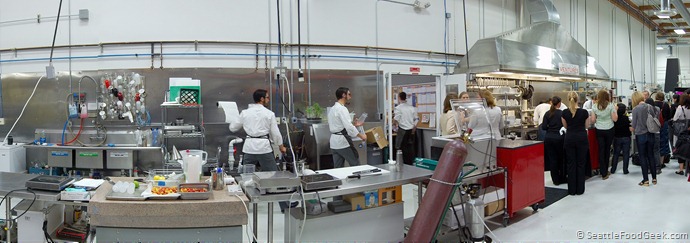
By the time we were ready for dinner service, the whole kitchen was electric with energy. I had the honor of wearing official Modernist Cuisine whites for dinner service, though I tried hard to hide my fanboy grin when I put on the jacket. It was kind of like getting to visit the set of Star Trek, put on a Lieutenant’s uniform, and fire off a few photon torpedoes. If that’s your thing, it’s unavoidable that you’ll pop a [metaphoric] boner in the process.
During dinner service, the other stages and I waited at-the-ready on the far side of the kitchen while the chefs, including Nathan, were “asses to elbows” firing and plating each course. Every now and then, one of the chefs would ask for “hands” and the lucky stage who happened to be closest got to jump in on the action. I had the privilege of helping plate several courses, including the Beef Stew, Polenta Marinara, Fruit Minestra and Banana Truffles. I even got to hop on the line for some last-minute morel chopping while the Morels and Cream course. Although my contributions were minor in the grand scheme of things, it gave me a huge rush of excitement just to be involved.
Watching Maxime and the other chefs in action was pretty amazing. Since the kitchen is open to the diners and only about ten feet away from their tables, any cuts, spills, burns, mistakes or re-fires would have been particularly noticeable. However, the chefs worked so smoothly and seamlessly together that their movement appeared choreographed. Every dish that left the kitchen looked good enough to photograph, even though they were often sending out 15 plates at a time. The servers, who have been retained through all of the previous dinners, were exceptionally knowledgeable about the menu and their professionalism and poise could make you forget, for a moment, that you were having a three-star meal in the hallway between a machine shop and a mosquito incubator. It really was a fantastic production, and I can say with certainty that it’s one of the most unique dining experiences on the planet.
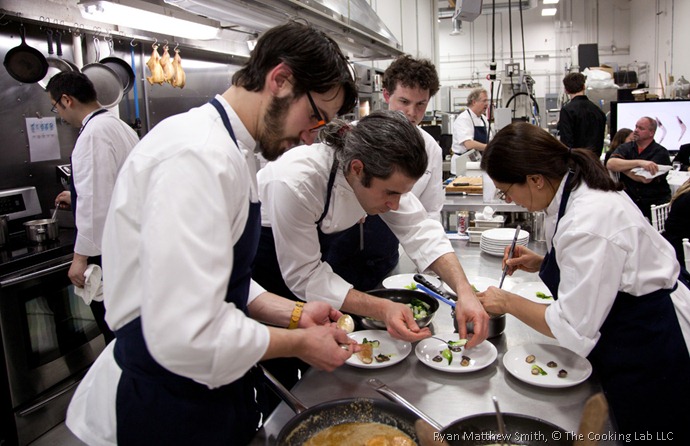
Now that I’ve had the pleasure of being both a guest at one of these dinners and helping to prepare it, I can tell you that time does not pass at equal rates on either side of the kitchen counter. Even thought the dinner I ate was just about the same length as the dinner we served, time flew by when I was seated and eating, though it seemed to crawl forward when I was on my feet shuttling ingredients around. It was about 10:30 PM by the time we had the kitchen clean and I took off my whites. By then, we were all a bit loopy. Maxime poured me a glass of leftover white wine and I nearly chugged it out of thirst and reflex. We nibbled on bits of leftovers, reflected on the success of the evening, swapped a few sophomoric jokes and finally parted ways. I cannot remember being more exhausted, nor can I remember feeling as proud for what I had helped accomplish in those four long days.
I want to publicly reiterate my sincere thanks to Sam, Grant, Johnny, Anjana, Aaron, Maxime and Nathan for allowing me this opportunity. It was an experience that I’ll never forget, and I’m sure it will play a formative role in my future cooking. I appreciate your generosity of time, knowledge and spirit and have a deepened respect for the work that you do.
If you’re interested in reading more about the meal itself, Alvin Schultz posted a great writeup. You can also check out the slideshow of my experience as a dinner guest at the lab, which covered many of the same courses.
Many thanks to Ryan Matthew Smith for the action shots above!
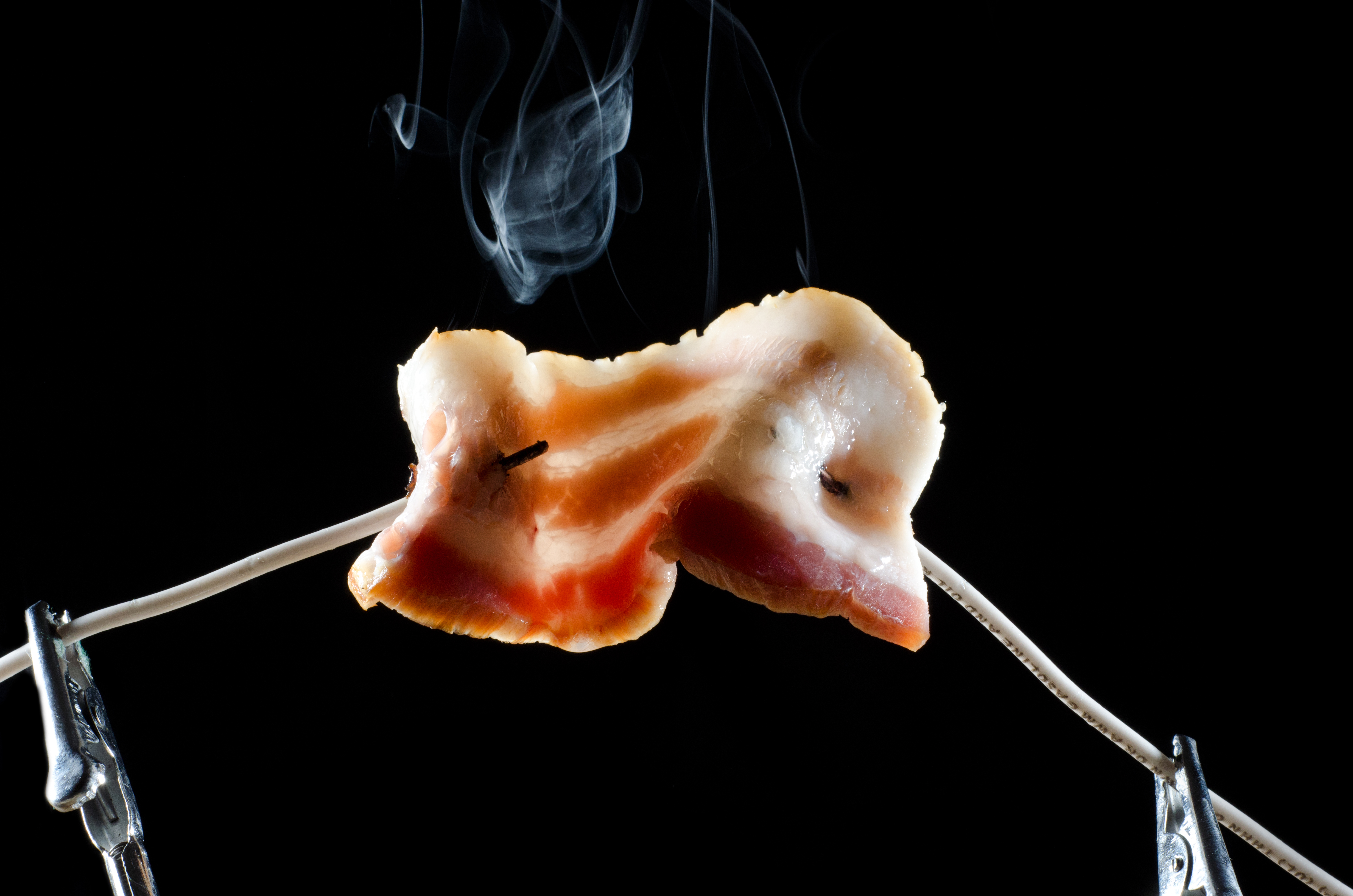
Wow, this was so exciting – what a fantastic write-up, Scott. I can just feel your aching feet (I remember the first double double with no Dr. Scholls too).
This is one of your most exciting posts so far. And I religiously read all of them. Some – many times…
This is so amazing! What an incredible opportunity. Seems like you made the most of it, really well done.
Scott-
A question for you: what is the technique for making corn juice. Are you simply putting thawed “frozen” corn into a juicer? What type of juicer(for a home kitchen) do you recommend for this?
Brian
Nothing like reading a whole post and ending up green with jealousy.
3 hours to do that corn…damn…did you hand juice it?
Pingback: A $2.50 Sleeve May Increase Battery Existence by Up to 800% | A $2.50 Sleeve May Increase Battery Existence by Up to 800%
What a fantastic experience! The attention to detail involved in reducing 60lb of corn to 120g of butter is incredible. Thanks for a fantastic write up.
Pingback: stage cuisine – Ikea Cuisine
Hello webmaster, i’ve been reading your articles for some time
and I really like coming back here. I can see that you probably don’t make money on your page.
I know one cool method of earning money, I think you will
like it. Search google for: dracko’s tricks